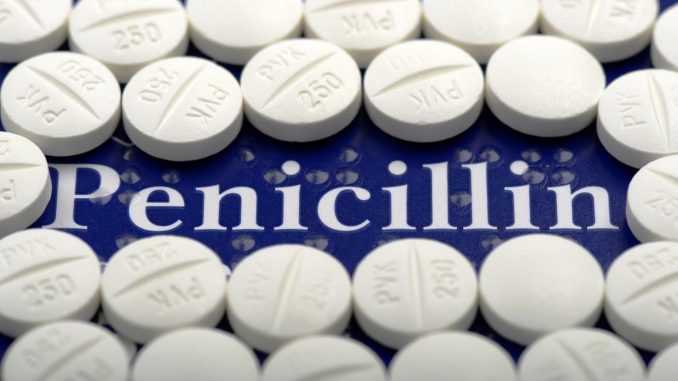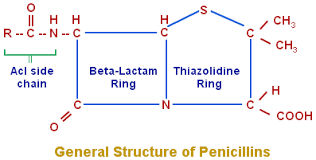
Penicillin: classification, mode of action and penicillin resistance
classification of penicillin:
- There are four clinically important class of penicillin classified into four groups on the basis of substitution of R group.

Group I: Natural penicillin
- These are active against Gram positive bacteria, very less against gram negative rods but act against gram negative cocci (gonococci and Meningococci)
- Susceptible to hydrolyse by β-lactamases.
- Examples: penicillin G( Benzyl penicillin), penicillin VK
Group II: β-lactamase resistant penicillin
- These penicillin are relatively stable to Staphylococcal β-lactamase enzyme.
- They have little activity against Gram positive bacteria
- Inactive against Gram negative bacteria
- Examples: Methicillin, Nafcillin, Oxacillin, Cloxacillin, Dicloxacillin
Group III: Aminopenicillins, Carboxypenicillins and Ureidopenicillins
- These antibiotics have higher activity against Gram Positive and gram Negative bacteria but are destroyed by β-lactamases
- Examples: Aminopenicillin (Ampicillin, Amoxicillin) Carboxypenicillins (Carcenicillin, Ticarcillin) and Ureidopenicillins (Mezlocillin, Piperacillin).
- Ampicillin and Amoxycillin are used against Enterobactericeae family but not against Klebsiella and Pseudomonas.
- Carboxypenicillins and Ureidopenicillinas are active against Piperacillin is drug of choice for Psudomonas
Group IV: Penicillin for oral administration
- These antibiotics are relatively stable to gastric acid and are suitable for oral administration.
- Examples: Penicillin V (Phenoxy methyl penicillin).
Mode of action of penicillin:
1. Inhibition of cell wall synthesis by blocking transpeptidation:
- Penicillin binds to penicillin binding protein (PBP) receptor on the surface of bacterial cell wall. PBP is the receptor for substrate peptidoglycan precursor in bacteria. Antibiotics penicillin acts as alternative substrate and binds to PBP receptor and then inhibits transpeptidase which results in inhibition of cell wall synthesis.
2. Activation of autolytic enzymes:
- Penicillin causes activation of autolytic enzymes of bacteria which creates lesion sin bacteria causing their death.
- Autolysins are present in bacterial cell wall which maintains appropriate shape and size of cell and also helps in cell division. The activity of autolysin is regulated by components such as cell wall and teichoic acid.
- Use of antibiotics penicillin causes destruction of cell wall and disintegration of teichoic acid as a result of which autolysin is activated and cause cell lysis.
Penicillin resistance:
Mechanism of resistance of bacteria towards penicillin is dependent on following conditions.
1. Ability of bacteria to produce β-lactamases enzyme:
- Bacteria like Staphylococcus, H. influenza, Gonococci and Gram –ve rods are resistant to penicillin because they produces β-lactamases enzyme which can hydrolyse the antibiotic penicillin.
2. Altered PBP receptor:
- Certain bacteria may be resistant to penicillin not because they produce β-lactamases but either due to altered PBP receptor or due to impermeability of their cell membrane to antibiotics.
3. Inability of penicillin to activate autolysin:
- In certain bacteria penicillin cannot activate autolysins to kill bacteria. In such case bacteria are only inactivated but not killed. Eg. Streptococcus, Listeria
4. Absence of cell wall:
- Bacteria which lacks cell wall are spontaneously resistant to penicillin. Eg. Mycoplasma
5. Mutation in gene:
- Certain bacteria such as Staphylococcus aureus are resistant to penicillin (β-lactamase resistant penicillins ie. Methicillin) known as MRSA. This resistant is due to mutation in gene which code altered penicillin binding protein (PBP).
Pharmacokinetics of penicillin:
- About 50% individuals are allergic towards penicillin. Allergy occurs in the form of type I hypersensitivity reaction.
